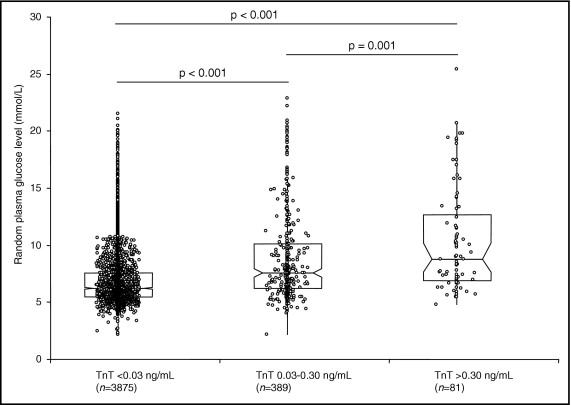There is clear evidence indicating that impaired glucose regulation is a risk factor for incident cardiovascular events and death. Increasing emphasis is also being placed on the predictive value of plasma glucose level on admission and clinical outcomes in hospitalized patients with acute myocardial infarction acute coronary syndromes (ACS), especially in those who undergo primary percutaneous coronary intervention.
The purpose of this study was to examine the relation between cardiac plasma troponin and random plasma glucose levels in a large sample of patients admitted to the emergency department (ED) with suspected ACS.
The study sample consisted of 2,304 men and 2,041 women (median age 60 years) who were consecutively admitted to the ED of the Verona University Hospital with nontraumatic chest pain and suspected ACS over a 2-year period (from January 2009 to January 2011). Nonfasting blood samples were obtained at ED admission. Plasma glucose and troponin T (TnT) levels were measured using a Modular System (Roche Diagnostics GmbH, Mannheim, Germany). The detection limit for the TnT immunoassay was 0.01 ng/ml, whereas the recommended diagnostic thresholds for myocardial injury and myocardial infarction were 0.03 to 0.30 and >0.30 ng/ml, respectively. Patients were stratified according to the diagnostic thresholds of plasma TnT. Results are expressed as median and interquartile range (IQR) and were analyzed using Kruskal-Wallis tests.
The main results of our study are summarized in Figure 1 . Overall, 81 patients had plasma TnT >0.30 ng/ml, 389 had TnT of 0.03 to 0.30 ng/ml, and 3,875 had TnT <0.03 ng/ml. As shown in Figure 1 , random plasma glucose level increased remarkably across TnT categories from 6.2 mmol/L (IQR 5.5 to 7.6) in patients with TnT <0.03 ng/ml, to 7.6 mmol/L (IQR 6.2 to 10.1) in those with TnT of 0.03 to 0.30 ng/ml, and up to 8.8 mmol/L (IQR 6.9 to 12.7) in those with TnT >0.30 ng/ml. The same significant trends were observed for men and women (data not shown). The prevalence of patients with random plasma glucose levels ≥11.1 mmol/L (i.e., an established glucose criterion for the diagnosis of diabetes) was 7% (n = 265), 20% (n = 77), and 32% (n = 26) in the 3 TnT categories, respectively (p <0.001 for trend). Notably, even after excluding those patients, random plasma glucose level on admission significantly increased across TnT categories, ranging from 6.1 mmol/L (IQR 5.4 to 7.2) in those with TnT <0.03 ng/ml, to 7.0 mmol/L (IQR 5.9 to 8.2) in those with TnT of 0.03 to 0.30 ng/ml, and up to 7.4 mmol/L (IQR 6.3 to 9.0) in those with TnT >0.30 ng/ml.





